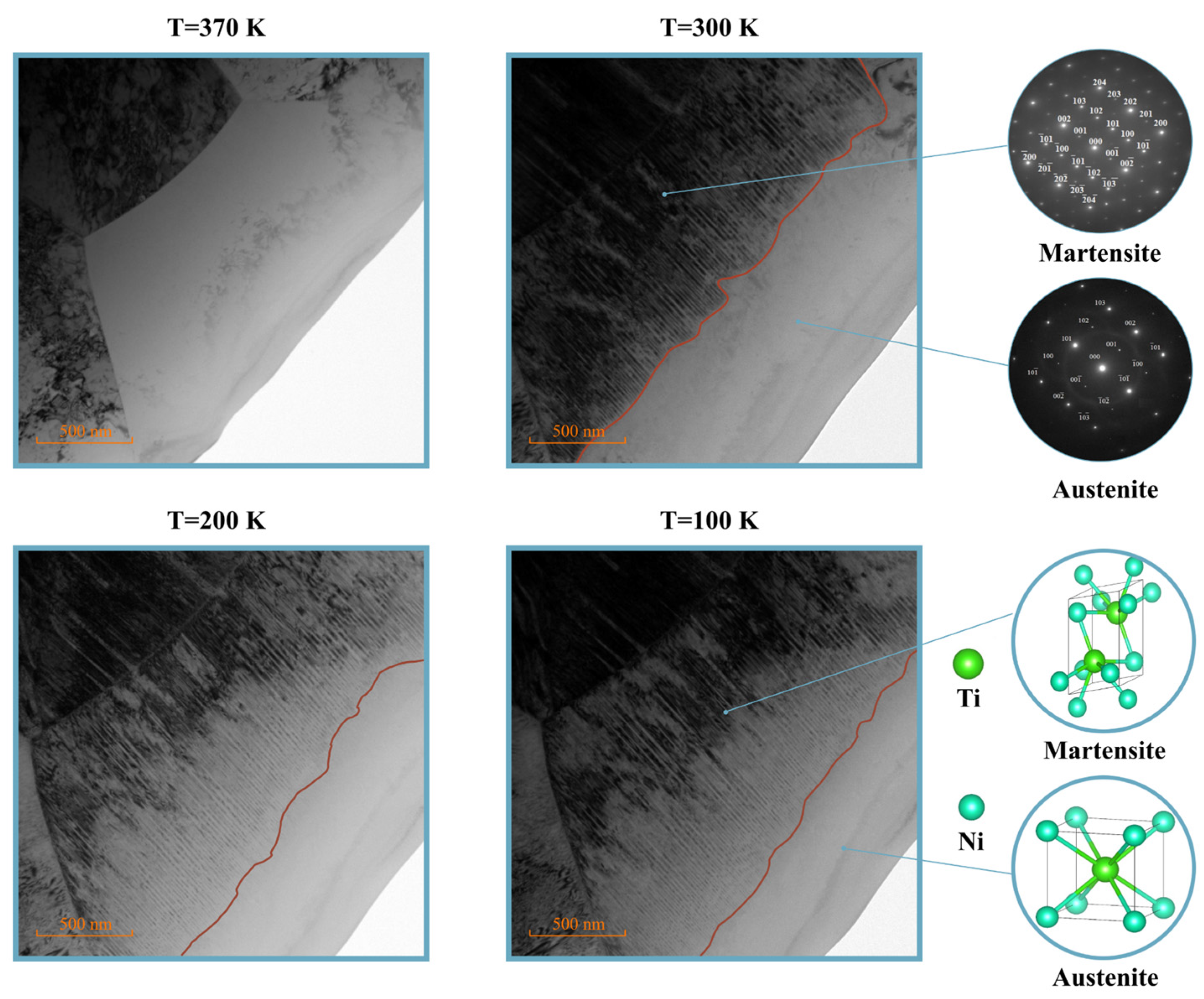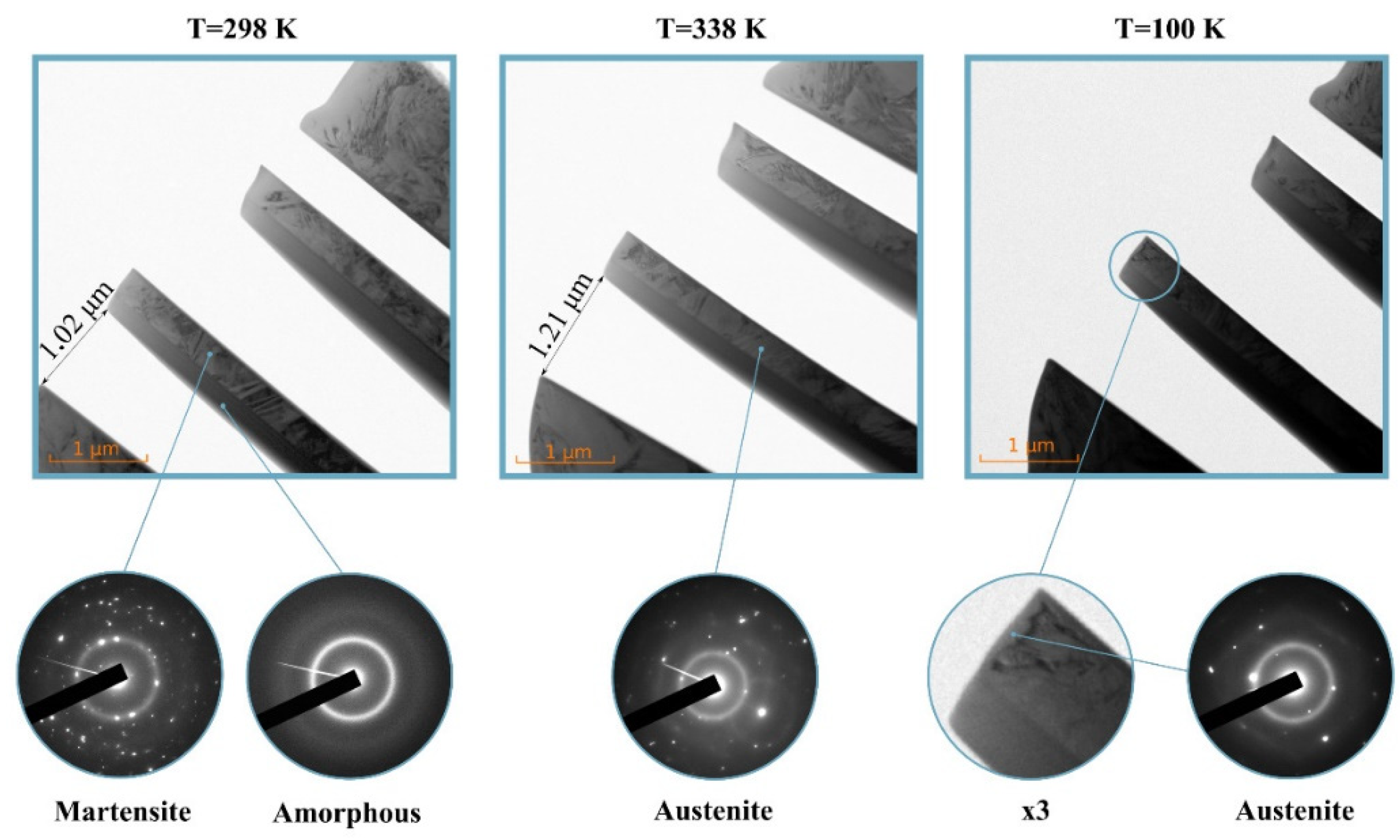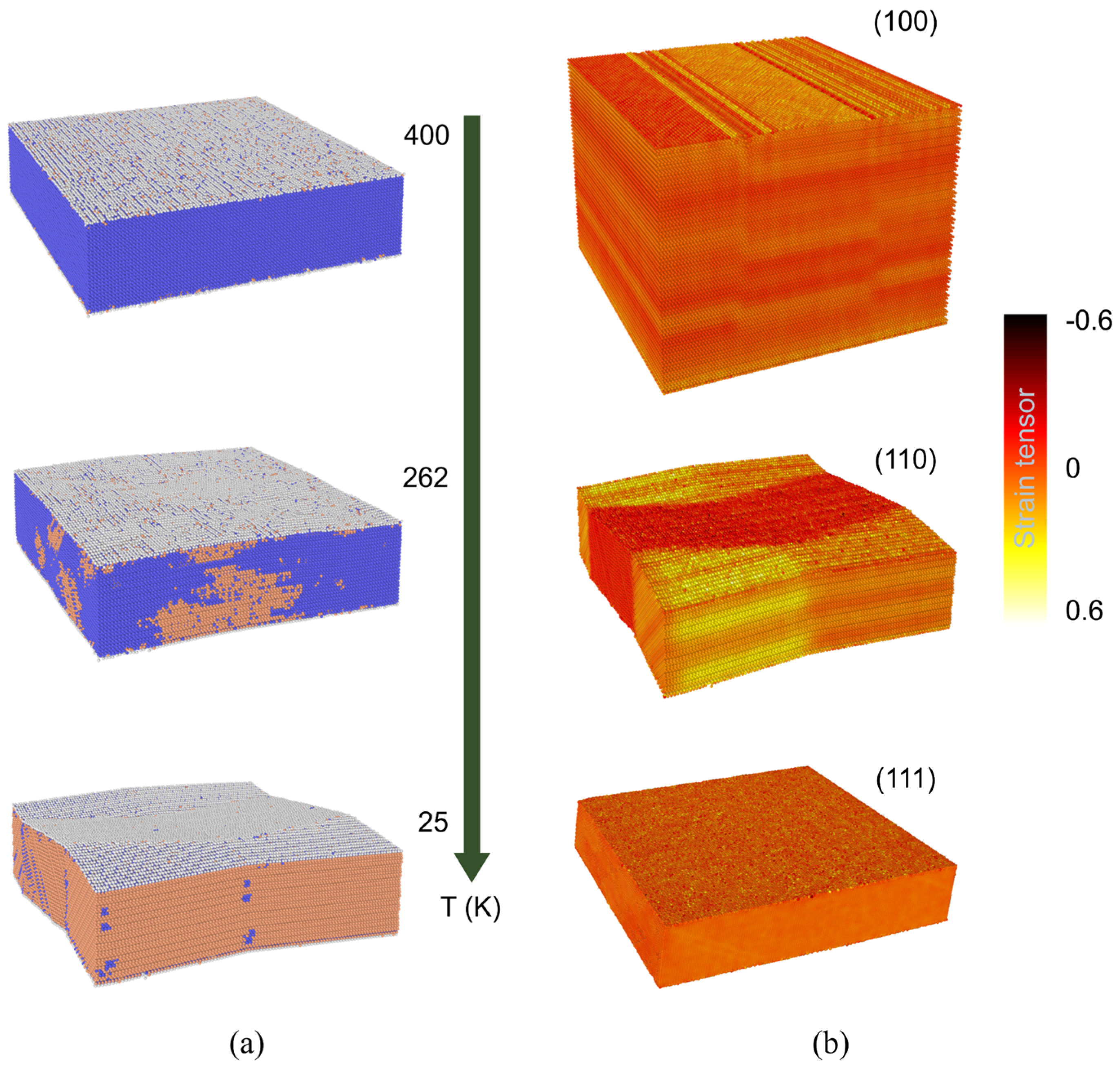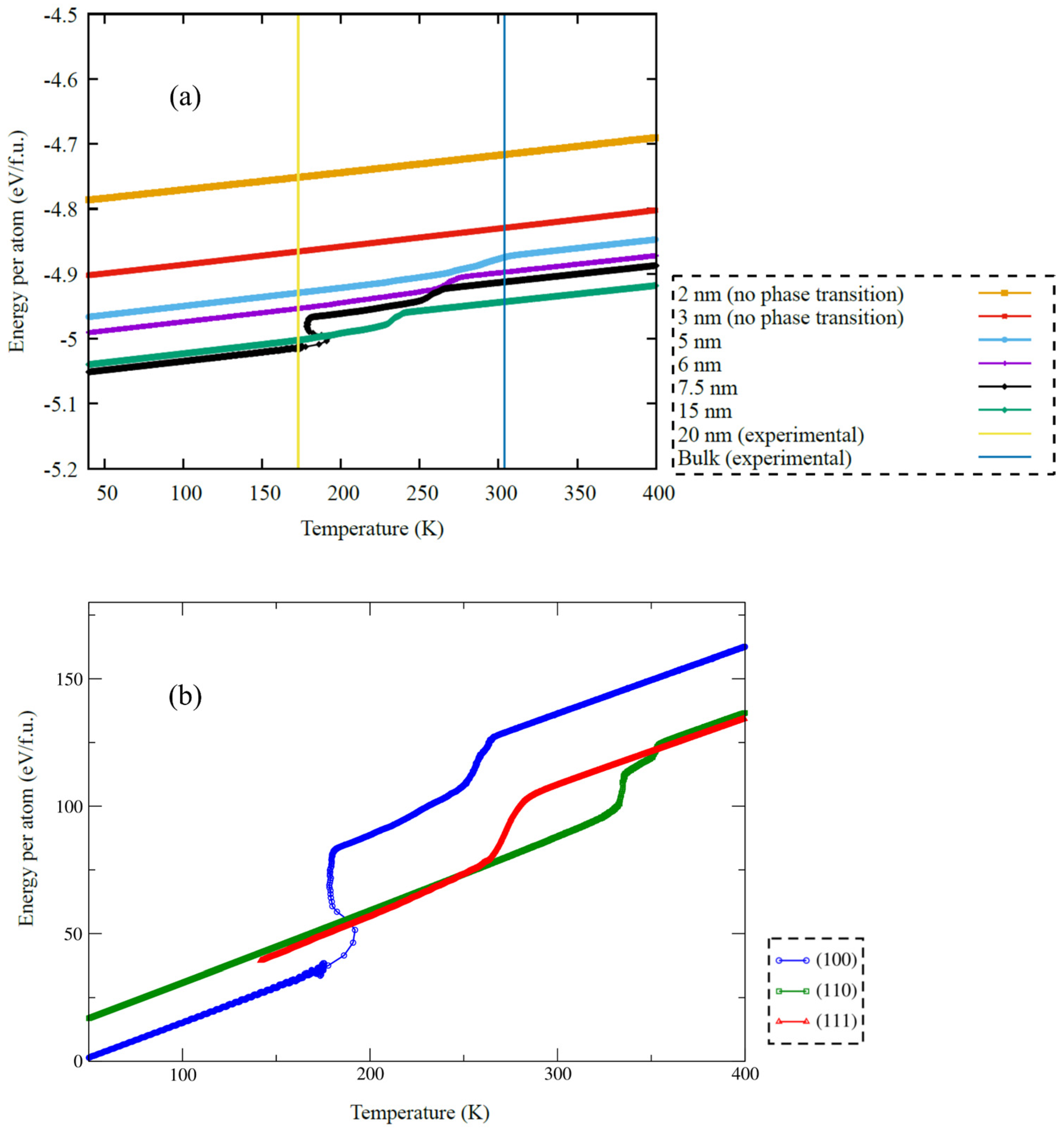Phase Transformation in TiNi Nano-Wafers for Nanomechanical Devices with Shape Memory Effect
Abstract
:1. Introduction
2. Methods
2.1. Experiment
2.2. Computational Details
2.2.1. Density Functional Theory
2.2.2. Molecular Dynamics Method
3. Results and Discussion
3.1. Experimental Part
3.1.1. Martensite Transformation
3.1.2. SME-Based Nano-Device in TEM
3.2. Computer Simulations
3.2.1. Thermodynamic Approach Based on the DFT Method
3.2.2. Molecular Dynamics Results
4. Conclusions
Author Contributions
Funding
Institutional Review Board Statement
Informed Consent Statement
Data Availability Statement
Acknowledgments
Conflicts of Interest
References
- Aviram, A.; Ratner, M.A. Molecular rectifiers. Chem. Phys. Lett. 1974, 29, 277–283. [Google Scholar] [CrossRef]
- Chernozatonskii, L.A.; Kosakovskaja, Z.J.; Fedorov, E.A.; Panov, V.I. New carbon tubelite-ordered film structure of multilayer nanotubes. Phys. Lett. A 1995, 197, 40–46. [Google Scholar] [CrossRef]
- Tans, S.J.; Verschueren, A.R.; Dekker, C. Room-temperature transistor based on a single carbon nanotube. Nature 1998, 393, 49–52. [Google Scholar] [CrossRef]
- Antropov, A.P.; Zaytsev, N.K.; Ryabkov, Y.D.; Yashtulov, N.A.; Mudrakova, P.N. Manufacturing of nanopillar (ultra-dispersed) catalytically active materials through chemical engineering. Fine Chem. Technol. 2021, 16, 105–112. [Google Scholar] [CrossRef]
- Franklin, A.D.; Luisier, M.; Han, S.J.; Tulevski, G.; Breslin, C.M.; Gignac, L.; Haensch, W. Sub-10 nm carbon nanotube transistor. Nano Lett. 2012, 12, 758–762. [Google Scholar] [CrossRef] [PubMed]
- Hills, G.; Lau, C.; Wright, A.; Fuller, S.; Bishop, M.D.; Srimani, T.; Shulaker, M.M. Modern microprocessor built from complementary carbon nanotube transistors. Nature 2019, 572, 595–602. [Google Scholar] [CrossRef]
- Zhang, Y.L.; Li, J.; To, S.; Zhang, Y.; Ye, X.; Sun, Y. Automated nanomanipulation for nano device construction. Nanotechnology 2012, 23, 065304. [Google Scholar] [CrossRef] [Green Version]
- Xie, H.; Régnier, S. High-efficiency automated nanomanipulation with parallel imaging/manipulation force microscopy. IEEE Trans. Nanotechnol. 2010, 11, 21–33. [Google Scholar] [CrossRef]
- Xie, H.; Haliyo, D.S.; Régnier, S. A versatile atomic force microscope for three-dimensional nanomanipulation and nanoassembly. Nanotechnology 2009, 20, 215301. [Google Scholar] [CrossRef] [Green Version]
- Peng, Y.; Cullis, T.; Inkson, B.J. Electrical nanowelding and bottom-up nano-construction together using nanoscale solder. J. Nanosci. Nanotechnol. 2010, 10, 7394–7397. [Google Scholar] [CrossRef]
- Koledov, V.; Shavrov, V.; Von Gratowski, S.; Petrenko, S.; Irzhak, A.; Shelyakov, A. Practical system for nanomanipulation. In Proceedings of the 2014 International Conference on Manipulation, Manufacturing and Measurement on the Nanoscale (3M-NANO), Taipei, Taiwan, 27–31 October 2014; pp. 316–320. [Google Scholar] [CrossRef]
- Mohammadzaheri, M.; AlQallaf, A. Nanopositioning systems with piezoelectric actuators, current state and future perspective. Sci. Adv. Mater. 2017, 9, 1071–1080. [Google Scholar] [CrossRef]
- Jang, J.E.; Cha, S.N.; Choi, Y.; Kang, D.J.; Hasko, D.G.; Jung, J.E.; Amaratunga, G.A. A nanogripper employing aligned multiwall carbon nanotubes. IEEE Trans. Nanotechnol. 2008, 7, 389–393. [Google Scholar] [CrossRef]
- Cagliani, A.; Wierzbicki, R.; Occhipinti, L.; Petersen, D.H.; Dyvelkov, K.N.; Sukas, Ö.S.; Bøggild, P. Manipulation and in situ transmission electron microscope characterization of sub-100 nm nanostructures using a microfabricated nanogripper. J. Micromech. Microeng. 2010, 20, 035009. [Google Scholar] [CrossRef]
- Li, W.; Qian, X.; Li, J. Phase transitions in 2D materials. Nat. Rev. Mater. 2021, 6, 829–846. [Google Scholar] [CrossRef]
- Zhang, P.; Liu, Z.; Duan, W.; Liu, F.; Wu, J. Topological and electronic transitions in a Sb (111) nanofilm: The interplay between quantum confinement and surface effect. Phys. Rev. B 2012, 85, 201410. [Google Scholar] [CrossRef] [Green Version]
- Budhia, H.; Kreith, F. Heat transfer with melting or freezing in a wedge. Int. J. Heat Mass Transf. 1973, 16, 195–211. [Google Scholar] [CrossRef]
- Chang, J.; Sakai, T.; Saka, H. Melting temperature of a cone-shaped Sn needle. Philos. Mag. Lett. 2005, 85, 247–257. [Google Scholar] [CrossRef]
- Chen, L.; Liu, J.; Jiang, C.; Zhao, K.; Chen, H.; Shi, X.; Zhang, Z. Nanoscale Behavior and Manipulation of the Phase Transition in Single-Crystal Cu2Se. Adv. Mater. 2019, 31, 1804919. [Google Scholar] [CrossRef]
- Liang, W.; Zhou, M.; Ke, F. Shape memory effect in Cu nanowires. Nano Lett. 2005, 5, 2039–2043. [Google Scholar] [CrossRef]
- Liang, W.; Zhou, M. Atomistic simulations reveal shape memory of fcc metal nanowires. Phys. Rev. B 2006, 73, 115409. [Google Scholar] [CrossRef] [Green Version]
- Sun, S.; Li, D.; Yang, C.; Fu, L.; Kong, D.; Lu, Y.; Han, X. Direct Atomic-Scale Observation of Ultrasmall Ag Nanowires that Exhibit fcc, bcc, and hcp Structures under Bending. Phys. Rev. Lett. 2022, 128, 015701. [Google Scholar] [CrossRef] [PubMed]
- Zheng, S.; Mao, S.X. Advances in experimental mechanics at atomic scale. Extrem. Mech. Lett. 2021, 45, 101284. [Google Scholar] [CrossRef]
- Ekimov, A.I.; Efros, A.L.; Onushchenko, A.A. Quantum size effect in semiconductor microcrystals. Solid State Commun. 1985, 56.11, 921–924. [Google Scholar] [CrossRef]
- Chibisov, A.N.; Pugachevskii, M.A.; Kuzmenko, A.P.; Than, M.M.; Kartsev, A.I. Effect of morphology and size on the thermodynamic stability of cerium oxide nanoparticles: Experiment and molecular dynamics calculation. Nanotechnol. Rev. 2022, 11, 620–624. [Google Scholar] [CrossRef]
- Buffat, P.; Borel, J.P. Size effect on the melting temperature of gold particles. Phys. Rev. A 1976, 13, 2287. [Google Scholar] [CrossRef] [Green Version]
- Lega, P.; Koledov, V.; Orlov, A.; Kuchin, D.; Frolov, A.; Shavrov, V.; Ari-Gur, P. Composite Materials Based on Shape Memory Ti2NiCu Alloy for Frontier Micro- and Nanomechanical Applications. Adv. Eng. Mater. 2017, 19, 1700154. [Google Scholar] [CrossRef]
- Landau, L.D.; Lifshitz, E.M. Statistical Physics: Volume 5; Elsevier: Oxford, UK, 2013; Volume 5. [Google Scholar]
- Kexel, C.; Schramm, S.; Solov’yov, V. Atomistic simulation of martensite-austenite phase transition in nanoscale nickel-titanium crystals. Eur. Phys. J. B 2015, 494, 221. [Google Scholar] [CrossRef]
- Kajiwara, S.; Ohno, S.; Honma, K. Martensitic transformations in ultra-fine particles of metals and alloys. Philos. Mag. A 1991, 63, 625. [Google Scholar] [CrossRef]
- Glezer, A.M.; Blinova, E.N.; Pozdnyakov, V.A.; Shelyakov, A.V. Martensite transformation in nanoparticles and nanomaterials. J. Nanopart. Res. 2003, 5, 551. [Google Scholar] [CrossRef]
- Pan, G.; Cao, Z.; Wei, M.; Shi, J.; Xu, L.; Meng, X. Thickness and grain size dependence of B2–R martensitic transformation behaviors in nanoscale TiNi films. Mater. Lett. 2014, 130, 285. [Google Scholar] [CrossRef]
- Ko, W.-S.; Maisel, S.B.; Grabowski, B.; Jeon, J.B.; Neugebauer, J. Atomic scale processes of phase transformations in nanocrystalline NiTi shape-memory alloys. Acta Mater. 2017, 123, 90–101. [Google Scholar] [CrossRef] [Green Version]
- Haskins, J.B.; Malmir, H. Low-Temperature Mechanical Instabilities Govern High-Temperature Thermodynamics in the Austenite Phase of Shape Memory Alloy Constituents: Ab Initio Simulations of NiTi, NiZr, NiHf, PdTi, and PtTi. Acta Mater. 2021, 212, 116872. [Google Scholar] [CrossRef]
- Wang, B.; Kang, G.; Yu, C.; Gu, B.; Yuan, W. Molecular dynamics simulations on one-way shape memory effect of nanocrystalline NiTi shape memory alloy and its cyclic degeneration. Int. J. Mech. Sci. 2021, 27, R713–R715. [Google Scholar] [CrossRef]
- Kuchin, D.; Lega, P.; Orlov, A.; Koledov, V.; Irzhak, A. The smallest and the fastest shape memory alloy actuator for micro-and nanorobotics. In Proceedings of the 2017 International Conference on Manipulation, Automation and Robotics at Small Scales (MARSS), Montreal, QC, Canada, 17–21 July 2017; pp. 1–4. [Google Scholar] [CrossRef]
- Kuchin, D.; Lega, P.V.; Frolov, A.V.; Irzhak, A.V.; Zhikharev, A.M.; Kamantsev, A.P.; Koledov, V.V.; Shelyakov, A.V.; Shavrov, V.G. High-Speed Composite Microactuator Based on Ti2NiCu Alloy with Shape Memory Effect. Phys. Solid State 2018, 60, 1163–1167. [Google Scholar] [CrossRef]
- Kresse, G.; Hafner, J. Theory of the crystal structures of selenium and tellurium: The effect of generalized-gradient corrections to the local-density approximation. Phys. Rev. B 1994, 49, 14251. [Google Scholar] [CrossRef] [PubMed]
- Perdew, J.P.; Burke, K.; Ernzerhof, M. Perdew, burke, and ernzerhof reply. Phys. Rev. Lett. 1998, 80, 891. [Google Scholar] [CrossRef]
- Blöchl, P.E. Projector augmented-wave method. Phys. Rev. B 1994, 50, 17953. [Google Scholar] [CrossRef] [Green Version]
- Ko, W.-S.; Grabowski, B.; Neugebauer, J. Development and application of a Ni-Ti interatomic potential with high predictive accuracy of the martensitic phase transition. Phys. Rev. B 2015, 92, 134107. [Google Scholar] [CrossRef] [Green Version]
- Plimpton, S.J. Fast parallel algorithms for short-range molecular dynamics. Comput. Phys. 1995, 117, 1–19. [Google Scholar] [CrossRef] [Green Version]
- Nosé, S. A unified formulation of the constant temperature molecular dynamics methods. J. Chem. Phys. 1984, 81, 511–519. [Google Scholar] [CrossRef] [Green Version]
- Hoover, W.G. Canonical dynamics: Equilibrium phase-space distributions. Phys. Rev. 1985, 31, 1695–1697. [Google Scholar] [CrossRef] [PubMed] [Green Version]
- Parrinello, M. Polymorphic transitions in single crystals: A new molecular dynamics method. J. Appl. Phys. 1981, 52, 7182. [Google Scholar] [CrossRef]
- Frøseth, A.G.; Van Swygenhoven, H.; Derlet, P.M. Developing realistic grain boundary networks for use in molecular dynamics simulations. Acta Mater. 2005, 53, 4847–4856. [Google Scholar] [CrossRef]
- Stukowski, A. Visualization and analysis of atomistic simulation data with OVITO—The Open Visualization Tool. Model. Simul. Mater. Sci. Eng. 2010, 18, 015012. [Google Scholar] [CrossRef]
- Lega, P.; Kartsev, A.; Nedospasov, I.; Lv, S.; Lv, X.; Tabachkova, N.; Koledov, V. Blocking of the martensitic transition at the nanoscale in a Ti2NiCu wedge. Phys. Rev. B 2022, 101, 214111. [Google Scholar] [CrossRef]
- Malygin, G.A. Nanoscopic size effects on martensitic transformations in shape memory alloys. Phys. Solid State 2008, 50, 1538–1543. [Google Scholar] [CrossRef]
- Orlov, A.P.; Frolov, A.V.; Lega, P.V.; Kartsev, A.; Zybtsev, S.G.; Pokrovskii, V.Y.; Koledov, V.V. Shape memory effect nanotools for nano-creation: Examples of nanowire-based devices with charge density waves. Nanotechnology 2021, 32, 49LT01. [Google Scholar] [CrossRef]
- Irzhak, A.V.; Lega, P.V.; Zhikharev, A.M.; Koledov, V.V.; Orlov, A.P.; Kuchin, D.S.; Tabachkova, N.Y.; Dikan, V.A.; Shelyakov, A.V.; Beresin, M.Y.; et al. Shape memory effect in nanosized Ti2NiCu alloy-based composites. Dokl. Phys. 2017, 62, 5–9. [Google Scholar] [CrossRef]
- Chevalier, J.; Gremillard, L.; Virkar, A.V.; Clarke, D.R. The tetragonal-monoclinic transformation in zirconia: Lessons learned and future trends. J. Am. Ceram. Soc. 2009, 92, 1901–1920. [Google Scholar] [CrossRef]
- Malygin, G. Synergetics of martensitic structures in shape memory crystals. Phys. Solid State 2000, 42, 1512–1516. [Google Scholar] [CrossRef]
- Deringer, V.L.; Caro, M.A.; Csányi, G. Machine learning interatomic potentials as emerging tools for materials science. Adv. Mater. 2019, 31, 1902765. [Google Scholar] [CrossRef] [PubMed]
- Song, Y.; Chen, X.; Dabade, V.; Shield, T.W.; James, R.D. Enhanced reversibility and unusual microstructure of a phase-transforming material. Nature 2013, 502, 85–88. [Google Scholar] [CrossRef] [PubMed]
- Teramoto, T.; Nagahira, K.; Tanaka, K. Geometry and energy barrier of martensite in the initial stage martensitic transformation in B19′TiNi shape memory alloy. Acta Mater. 2020, 201, 94–101. [Google Scholar] [CrossRef]
- Sorokin, A.A.; Makogonov, S.V.; Korolev, S.P. The information infrastructure for collective scientific work in the Far East of Russia. Sci. Tech. Inf. Process. 2017, 44, 302–304. [Google Scholar] [CrossRef]






Publisher’s Note: MDPI stays neutral with regard to jurisdictional claims in published maps and institutional affiliations. |
© 2022 by the authors. Licensee MDPI, Basel, Switzerland. This article is an open access article distributed under the terms and conditions of the Creative Commons Attribution (CC BY) license (https://creativecommons.org/licenses/by/4.0/).
Share and Cite
Kartsev, A.; Lega, P.V.; Orlov, A.P.; Pavlov, A.I.; von Gratowski, S.; Koledov, V.V.; Ilin, A.S. Phase Transformation in TiNi Nano-Wafers for Nanomechanical Devices with Shape Memory Effect. Nanomaterials 2022, 12, 1107. https://doi.org/10.3390/nano12071107
Kartsev A, Lega PV, Orlov AP, Pavlov AI, von Gratowski S, Koledov VV, Ilin AS. Phase Transformation in TiNi Nano-Wafers for Nanomechanical Devices with Shape Memory Effect. Nanomaterials. 2022; 12(7):1107. https://doi.org/10.3390/nano12071107
Chicago/Turabian StyleKartsev, Alexey, Peter V. Lega, Andrey P. Orlov, Alexander I. Pavlov, Svetlana von Gratowski, Victor V. Koledov, and Alexei S. Ilin. 2022. "Phase Transformation in TiNi Nano-Wafers for Nanomechanical Devices with Shape Memory Effect" Nanomaterials 12, no. 7: 1107. https://doi.org/10.3390/nano12071107





